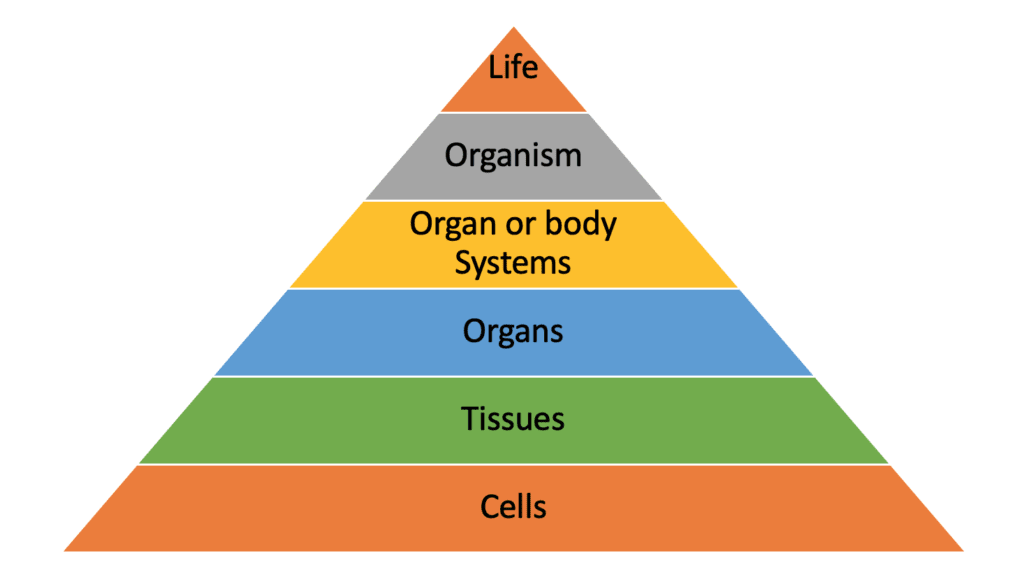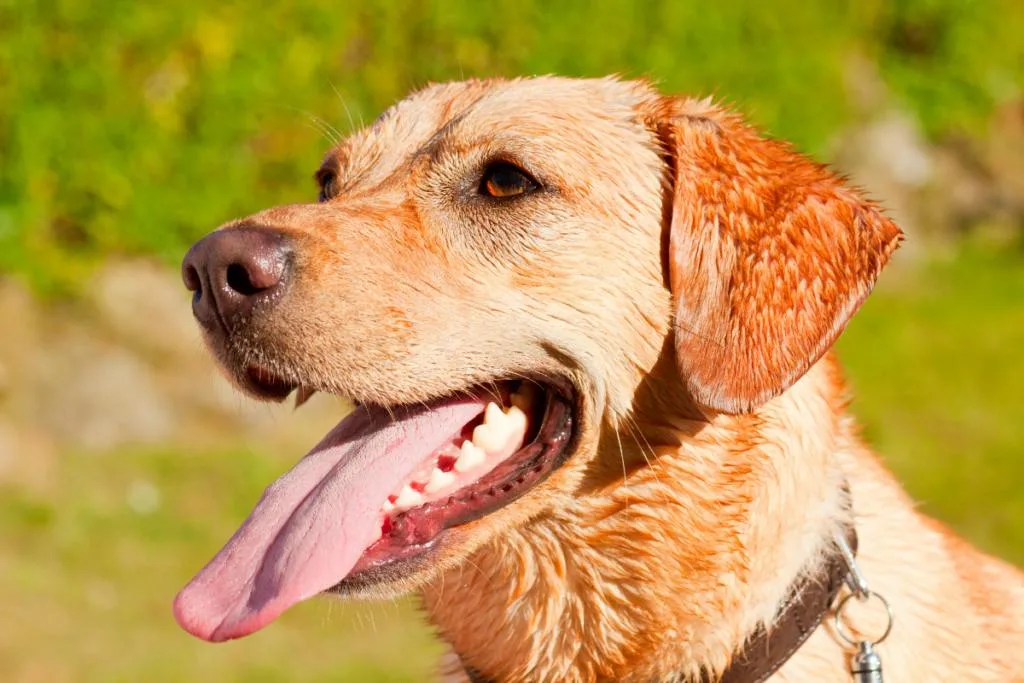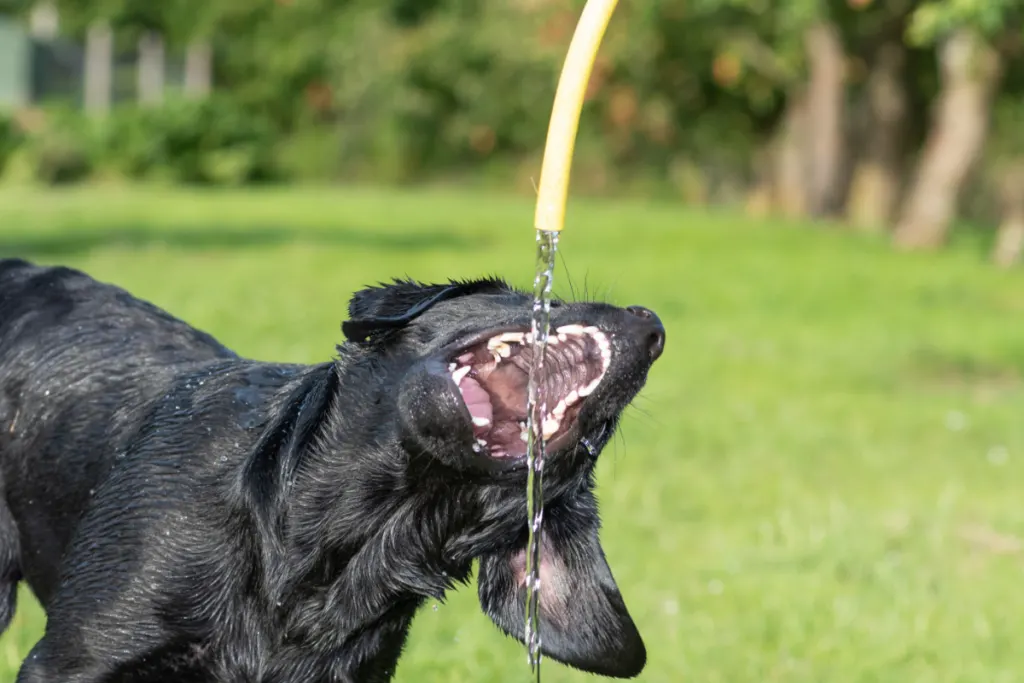It is distressing to witness your Labrador curling up in a freezing ball of miserable dog or watch them panting as if their lives depend on it.
Learning how to manage your Labrador’s environment is an essential step to ensuring your Labrador receives the best care!
Labradors can tolerate temperatures that range from 20°F and up to around 90°F. However, their temperature preference is between 50°F and 80°F. It is very important to limit a Labrador’s time in cold and hot weather alike, and to provide an easily accessible heat source for cold weather and plenty of cold, fresh water for hotter days.

There is no one-size-fits-all answer to temperature tolerance in dogs; each dog breed is different, and each dog within the breed is a unique individual.
A specific Labrador’s temperature tolerance for upper and lower temperatures depends on the efficacy of the thermoregulatory mechanisms employed, dog-specific variables, and environmental factors.
Click Here to Jump to a Section
The Importance Of Thermoregulation In Labradors
Most people recognize that extremes of temperature (i.e., too cold or too hot) are dangerous and can be fatal.
However, few people understand the mechanism of actions that cause these temperatures to have detrimental or lethal effects.
Humans, dogs, and other living beings are made up of cells; these cells form tissues, which in turn function as part of an organ.
Each organ belongs to one or more organ systems, and all the organ systems work together to support the organism.

A Labrador’s life is supported by processes occurring on the cellular level.
Protoplasm is a fluid substance found within cells, and it contains all the cellular structures and enzymes needed to perform the different cellular functions.
These enzymes operate within a narrow temperature range. When the temperature range drops below or above the enzyme’s optimal temperature range, the enzymes are denatured, i.e., uncoiled, damaged, and unable to perform.
Once this damage has occurred, the cell can no longer function correctly. If the cell damage occurs in an isolated area, the Labrador’s body can deal with the damage efficiently.
However, the greater the extent of damage, the more it negatively affects a Labrador’s well-being.
The Ideal Core Body Temperature For Labradors
Adult Labradors should maintain a body temperature of 101.0°F to 102.5°F (38.3°C to 39.2°C).
An adult Labrador with a temperature exceeding 104°F (40.0°C) is at risk of hyperthermia (i.e., getting too hot). In comparison, a Labrador with a temperature cooler than 99°F (37.2°C) is at risk of developing hypothermia (i.e., getting too cold).
Puppies’ temperatures differ from those of adult Labradors. The ideal temperature for Labrador puppies is:
- Newborn puppy: 95°F to 99°F (35°C to 37.2°C)
- 1- to a 3-week-old puppy: 97°F to 100°F (36.1°C to 37.8°C)
- 4 weeks and older puppy: 101.0°F to 102.5°F (38.3°C to 39.2°C)
Both puppies and adult Labradors may die if their temperatures drop below 94°F (34.3°C) or above 106°F (41.1°C)
(Source: VCA Hospitals – puppies; VCA Hospitals – adults; AKC)
How Do Labradors Thermoregulate?
It is truly awe-inspiring how the Labradors can live in an environment with significant temperature variances while maintaining their core temperature within the incredibly narrow margin required to support life!
The Physics Of Thermoregulation In Labradors
Energy (i.e., heat) always moves from an area of high energy (i.e., hot places) to areas of low energy (i.e., cool places). Labradors rely on four principles of energy transfer to maintain their ideal core body temperature:
- Convection: the transference of energy due to air displacement, e.g., wind
- Conduction: the transference of heat energy to a cold surface
- Thermal radiation: the release of heat energy into the atmosphere
- Evaporation: the energy required to support the transformation of liquid into a gas
(Sources: Thermoregulation in Dogs)
The Neutral Temperature Zone For Labradors
The thermal neutral zone is the ambient temperature at which a Labrador does not have to expend energy to maintain its core body temperatures.
In most dogs, the thermal neutral zone is between 68°F to 86°F (20 °C to 30°C). However, the upper and lower critical temperatures vary between dog breeds and individual dogs.
Puppies have immature thermoregulatory mechanisms and, as such, require higher neutral temperatures to maintain their core temperatures. The ideal environmental temperatures for puppies are:
- Newborn puppies: 85°F to 90°F (29.4°C to 32.2°C)
- 1- to 3-week old puppies: 80°F to 85°F (26.7°C to 29.4°C)
- 4 weeks: 72°F to 85°F (22.2°C to 29.4°C)
(Source: VCA Hospitals – puppies; Thermoregulation in Dogs)
Thermoregulatory Mechanisms In Labradors
When the environmental temperatures exceed a Labrador’s neutral zone, they use various mechanisms to maintain their core body temperature within the optimum range. These mechanisms include:
- Behavioral modifications
- Heat generation and conservation
- Heat transfer
Behavioral Thermoregulation In Labradors
Behavioral thermoregulation refers to a Labrador’s voluntary responses to changes in environmental temperature. During hot days your Labrador may choose to go swimming, lie in the shade or stretch out on cool surfaces.
Vasodilation in the skin’s capillaries (i.e., increased blood flow to the body surfaces) allows the Labrador to utilize the principles of conduction and thermal radiation.
By increasing the total surface contact between the Labrador’s warm blood-filled skin and the cold surface (e.g., water or floor), heat energy is transferred from the body to the cooler surface, cooling the Labrador.
On cold days, your Labrador will still use the principles of conduction and thermal radiation, except this time, your Labrador will be aiming to increase the energy absorbed from the environment and decrease energy lost to the environment.
Your Labrador will curl up into a tight ball during cold weather, reducing the body surfaces exposed to the air, thereby decreasing the heat energy lost via conduction and convection.
They will also look for warm places to sleep, e.g., near a heater, inside the house, or curling up with their human or dog friends.
Heat Generation And Conservation In Labradors
In response to temperatures below a Labrador’s critical temperature tolerance, the Labrador will have three physiological responses:
- Vasoconstriction of capillaries in the skin
- Increased metabolism and shivering
- Improving insulation by increasing fat deposits
Vasoconstriction of blood capillaries is the opposite of vasodilation; blood is directed away from the skin and towards the Labrador’s vital organs.
This process reduces the heat energy lost at the skin surface and protects the vital organs from oxygen deprivation.
This re-direction of blood towards the vital organs explains why your Labrador’s extremities (e.g., tips of ears, toes, and tail) are vulnerable to frostbite in cold conditions.
Shivering and an increased metabolic rate generates heat, allowing your Labrador to raise their core temperature in cold climates.
Like people, Labradors living in cold climates often develop a layer of body fat. Fat acts as an insulation layer as it is a poor conductor of thermal energy and thus prevents the unnecessary loss of heat energy to the environment.
Labradors wearing jerseys and snuggling in blankets use a similar insulation process to prevent loss of body heat.
Heat Transfer Strategies In Labradors

When humans sweat, the heat from the skin and environment causes the liquid sweat to evaporate as gaseous molecules.
This conversion of liquid to gas requires energy, which results in the skin’s surface cooling down.
Unlike humans, Labradors only have sweat glands in their ear canals and footpads.
The limited number of sweat glands means that sweating is an ineffective method of cooling in dogs.
Despite Labradors’ inability to sweat profusely, they still use the principles of evaporation and convection to cool themselves down. When a Labrador pants, three things happen:
- Warm air is exhaled, and cooler air is inhaled
- Saliva coating the moist membranes in the mouth (i.e., gums and tongue) evaporates, cooling these surfaces
- Increased blood flow to the mouth allows convection to occur. The blood is cooled and returns to the rest of the body at a lower temperature.
Typically, Labradors’ resting breathing rate is between 30 to 40 breathes per minute, but when dogs pant to cool down, their breathing rate increases to a staggering 200 to 400 breathes per minute!
The video below breaks down thermoregulation in dogs in a very helpful manner. It’s certainly worth a look, as it covers some extremely important safety tips, and contains some really eye opening information.
(Sources: Thermoregulation in Dogs; PetMD; The Kennel Club)
Laws Regarding The Optimum Conditions For Dogs
Although state-specific laws may differ, the Animal Welfare Act has described clear parameters regarding the environmental conditions in which government-owned dogs, research dogs, and working dogs must be kept.
Ambient temperature conditions should not fall below 50°F (10°C) nor exceed 85°F (29.5°C) at a humidity level of 30% to 70%.
Animals kept in conditions with restricted mobility (e.g., kennels) should receive sufficient ventilation to prevent the unnecessary accumulation of ammonia, unpleasant smells, and moisture condensation.
In addition to these restrictions, the temperature should not fall below 45°F (7.2°C) nor exceed 85°F (29.5°C) for more than 4 consecutive hours.
While these conditions apply to non-pet dogs, it nevertheless provides a guideline for Labrador owners who are uncertain about managing their Labrador’s environmental conditions.
(Source: USDA Animal Welfare Act; Purdue University)
A Labrador’s Temperature Tolerance
Labrador retrievers originated in the Canadian coastal town of Newfoundland. There they assisted the local fishermen in their duties:
- Hauling in nets
- Fetching fish who had slipped the fishermen’s hooks
- Retrieving items lost to the water, e.g., the fishermen’s caps
These prototype Labradors spent their lives in the water helping the people get their work finished.
Initially, this may seem like a random anecdote, unrelated to a Labrador’s temperature tolerance until you consider that the average summer temperatures in Newfoundland are 61°F (16°C) while winters are a chilly 32°F (0°C). The highest temperatures reached are 77°F (25°C).
Not only did Labradors work in these conditions, but they also swam in the Atlantic Ocean, which is even colder!
Labradors are better at tolerating cold conditions than hot conditions due to their:
- Thick, waterproof coats
- Good body insulation
- Reduced body surfaces, e.g., smaller ears and short otter-like tails
(Sources: AKC; Newfoundland)
Environmental Factors Affecting Temperature Tolerance
It isn’t easy providing a definitive answer to the breed’s temperature tolerance as many factors influence how well a Labrador copes with various temperatures.
The two most common environmental factors influencing a Labrador’s temperature tolerance are humidity and wind chill (e.g., ventilation indoors and wind outdoors).
High levels of atmospheric humidity reduce the effectiveness of the Labradors panting. When the air is at or close to saturation, condensation and not evaporation will occur.
The upper critical temperature for Labradors is typically 86°F (30°C) at 70% saturation. If humidity levels increase beyond 70%, the Labrador’s thermoregulatory mechanisms are less effective, and the Labrador will begin to overheat at 86°F.
The efficacy of convection is dependent on the speed of the wind passing over the Labrador’s body. The heat lost due to wind convection will increase on windy days, and the Labrador will be less tolerant of cold temperatures.
The converse is also true. The Labrador will remain comfortable during hot, windy days even if the temperature exceeds the neutral zone by 3°F to 5°F.
(Sources: Frontiers in Veterinary Science)
Non-Environmental Factors Affecting Temperature Tolerance
Not all factors that affect a Labrador’s temperature tolerance are environmental; non-environmental factors are individual variables that affect how well a specific Labrador copes with temperatures above or below the neutral temperature range.
These variables include:
- Health status
- Gender
- Body condition
- Coat color and quality
- Age
- Fitness
- Acclimation to a specific temperature
Health Status Affecting Temperature Tolerance

A Labrador with compromised health will also show changes in their temperature tolerances.
For example, hypothyroidism which causes a decreased metabolic rate, impairs Labradors’ heat generation mechanisms. Thus, Labradors with hypothyroidism will be less cold tolerant than healthy Labradors.
Another condition that will cause a Labrador to show altered thermoregulatory mechanisms is a Labrador with an infection-induced fever.
The Labrador’s brain sends signals to its body that it’s cold and needs to warm up.
The Labrador then begins shivering and showing behavioral signs of trying to warm themselves.
The increased heat generation and conservation cause the Labrador’s core body temperature to be raised; temperatures exceeding 106°F (41.1°C) are often fatal to Labradors.
Gender Affecting Temperature Tolerance
Testosterone levels in unneutered adult male Labradors are much higher than all other Labradors. Testosterone is linked to an increased metabolic rate which results in higher temperatures.
Unneutered male Labradors are more cold tolerant and less heat tolerant than many other Labradors.
Body Condition Affecting Temperature Tolerance
Earlier, I spoke about how a Labrador’s natural body fat acts as an insulating layer, affecting thermal radiation and convection.
Obese Labradors have more insulation than other Labradors and thus will be more vulnerable to heatstroke during hot weather.
The converse is also true; underweight Labradors lack the insulation necessary to cope with cold weather and thus are more likely to develop hypothermia than healthy or slightly overweight Labradors.
Coat Colour And Quality Affecting Temperature Tolerance

Most people do not consider the temperature effects of coat color when selecting their Labradors.
Dark coat colors like black and chocolate absorb more colors of the light spectrum and thus are more vulnerable to heat-induced illnesses when exposed to direct sunlight.
In contrast, yellow Labradors are better able to tolerate hot temperatures because less energy is absorbed by the pigment in their hair follicles.
Age Affecting Temperature Tolerance
Puppies and senior Labradors have compromised thermoregulatory mechanisms. These vulnerable Labradors will be more reliant on their owners to control the environmental temperatures than healthy adult Labradors.
For both puppies and senior Labradors, cold tolerance is affected more than their heat tolerance.
Fitness Affecting Temperature Tolerance
Fit Labrador’s are better able to cope with hot and cold temperatures. As a Labrador’s fitness improves, the metabolic rate increases making them better able to tolerate cold weather.
A concurrent increase in thermoregulatory mechanisms, specifically energy exchange rates and decreased body fat allow fit Labradors to also tolerate warm weather better.
Acclimation Affecting Temperature Tolerance
A Labrador’s physiology and anatomy are incredible in their resilience and adaptability. Labradors can learn to tolerate colder temperatures if given enough time.
It typically takes 10 to 60 days for a Labrador to acclimate to a lower temperature. During this time, their metabolic rates, fat deposits, and circulatory systems will change in response to the environmental stressor, i.e., colder conditions.
(Sources: Nottingham Trent University; PetMD; VCA Hospitals; Purdue University)
Final Thoughts
Most labradors can comfortably tolerate temperatures between 32°F to 77°F.
However, each Labrador’s temperature tolerance will be based on their individual characteristics, environmental factors, and the efficacy of the thermoregulatory mechanisms used to maintain their body temperature.
Owners must monitor their Labradors for hyperthermia and hypothermia and make adjustments to the Labradors’ environmental conditions as needed.
